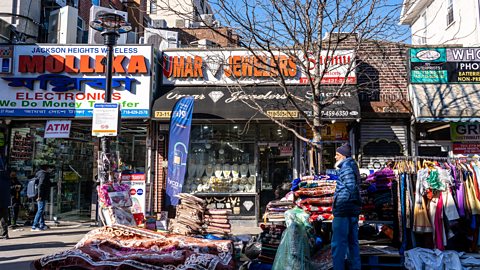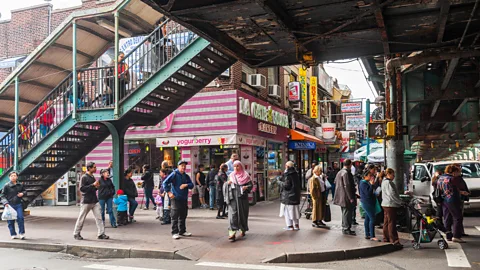Jackson Heights: The neighbourhood that epitomises New York
 Richard Levine/Alamy
Richard Levine/AlamyTravellers may go to Central Park or Times Square to see New York City, but there's no better place to feel the city's DNA and understand how it started than here.
A few months after moving to New York City, I struck up a conversation with a woman from the borough of Queens. "Where are you from?" she asked. "Well, it's a little complicated," I started, preparing for the spiel anyone with peripatetic roots has down pat.
"I'm half Colombian and half Indian–"
"Oh, so you're from Jackson Heights?" she interrupted.
I'm not, but it wasn't a bad guess. I soon learned that Jackson Heights, a neighbourhood in the north-western corner of Queens, is famous for being one of the most diverse places on Earth. In one section of it, an area called Little Colombia runs right into Little India – hence the woman's educated guess – and that's only scratching the surface. It's hard to nail down exact numbers, but Jackson Heights is thought to be home to roughly 180,000 people who speak at least 160 languages.
 Sebastian Modak; mural by Erick Teran
Sebastian Modak; mural by Erick TeranOn the neighbourhood's southern edge, cutting through Queens like a backbone, is Roosevelt Avenue. Here, conversations don't stop when the 7 train rattles overhead, they just get louder. Phone repair shops run by Tibetans with makeshift shrines displayed between plastic iPhone covers abut Latin American bakeries churning out pillowy almojábanas (Colombian cheese bread) and crispy empanadas. On a recent visit, a woman shouted over the never-ending din, hawking tamales that sent pillars of steam into the cold air. Nearby, a man sold knock-off electronics, prepared for a well-rehearsed disappearing act at the sight of a police officer. It's intimidating at first – so many languages, so much for sale – but lock into the frenetic rhythm of the place and it becomes hypnotic.
Like New York City itself, Roosevelt Ave is a bustling, intoxicating, maelstrom of cultural exchange and commerce. It's messy and not always pretty, but if you know where to look, you can find magic. In other words, it's the epitome of New York City: a clamorous, capitalistic milieu drawing people from across the world who have come to try to better their lives and that of their children.
So, while visitors may be more likely to visit Central Park or the Statue of Liberty to see the Big Apple, there's no better place than Jackson Heights to feel the city's DNA, understand how it started and glimpse where it could be going.
"To me, Jackson Heights feels like the ideal version of New York City – it's what the city can be," said Esthi Zipori, who is originally from Israel and moved to the neighbourhood seven years ago. When not teaching urban planning courses to university students, Zipori helps her husband run Sandwich Therapy, a pop-up food stand that specialises in "Israeli-Georgian food that's inspired by the neighbourhood".
 Sebastian Modak
Sebastian ModakZipori has lived in other parts of the city, but in Jackson Heights, it was love at first sight. "We have such a close community here that's made up of immigrants – we feel like we belong here," she said. "When I see tourists here it's usually people who have been to New York before and they've done the touristy stuff, but now they want to see the real thing."
She wasn't the only person I met who takes pride in the neighbourhood's multiculturalism. "What I love about Jackson Heights is that every single avenue has its own personality," said Oscar Zamora Flores, a graduate student at Queens College who grew up between Mexico and Jackson Heights. "There are avenues that are really relaxed, with beautiful architecture, and then you get to Roosevelt, just a few blocks away, and it's crazy and overwhelming and sometimes so packed you can't even walk."
I met Zamora Flores at Seba Seba, one of a few dozen Colombian restaurants and bakeries in the neighbourhood. "When I was living here as a kid, I could count the number of times I went into Manhattan on one hand," he said. "There was no reason to go, everything I needed was here."
Follow the crowds east from Diversity Plaza, a pedestrian zone near the Jackson Heights-Roosevelt Avenue subway entrance, and Little India (somewhat of a misnomer considering the equal number of Tibetans, Nepalis, Bangladeshis, Pakistanis and other groups who live here) becomes Little Colombia (and Ecuador, Peru, Argentina and Uruguay). That, in turn, blends into the beating heart of Queens's LGBTQ community centred on Friend's Tavern, the oldest gay bar in Queens. "Unlike at the gay bars in other parts of the city, here every night is Latino night," Zamora Flores said.
 Sebastian Modak
Sebastian ModakThere's a kind of poetic justice to Jackson Heights becoming a place that celebrates diversity. Before World War One, the area was a largely uninhabited marshland called Trains Meadow where people would hunt foxes and geese, according to Jason Antos, the executive director of the Queens Historical Society. The land was purchased by Edward A MacDougall's Queensboro Corporation in 1914, with the vision of creating a place where middle- and upper-middle-class white Americans could live in gorgeously appointed English-style courtyard apartments, while still being close to Manhattan. It was also a so-called "restricted community", where people of colour, Jews and other marginalised groups were prohibited from purchasing property.
White people moved to the neighbourhood in droves, especially when the IRT subway line (now the 7 train) was extended down into the heart of Jackson Heights in the final months of WWI. But MacDougall's vision didn't last. After New Yorkers resisted and protested the racist segregation laws of the period for years, they finally managed to desegregate the neighbourhood after World War Two, eventually leading to the Jackson Heights of today.
These days, visitors to Jackson Heights tend to come to the neighbourhood hungry, and its reputation as one of the city's culinary meccas is understandable. Residents here talk about food carts and restaurants with an unbridled passion you'll never find amid the sports bars and chain restaurants of Midtown Manhattan. Bridget Bartolini, an oral historian and the founder of the Five Boro Story Project, which aims to strengthen community connections through storytelling events, is from elsewhere in Queens, but moved to Jackson Heights in 2016. On a walk down 34th Avenue, which has been turned into an "Open Streets" pedestrian zone since the Covid-19 pandemic, I asked her if she ever takes the diversity of the neighbourhood for granted.
"Absolutely not – that's one of the reasons I love it here," she said, as we went in search of her favourite Kashmiri chai (Al Naimat Sweets & Restaurant). "This morning I went to a Lebanese place for brunch. There's Bangladeshi food carts on my corner, Tibetan momos a few steps away… and it's all so good because people originally from these countries are making it for people from those countries."
 Sebastian Modak
Sebastian ModakFor chef Esneider Arevalo, Jackson Heights was the obvious place to begin the food-focussed walking tour that he offers through Culinary Backstreets. He moved from Colombia to Jackson Heights 34 years ago, joining his mother who has garnered local fame as the Arepa Lady, transforming her business from an unlicensed food stand to a growing collection of brick-and-mortar restaurants.
"My goal with the tours is to show the diversity of languages, cultures and religions all through food," Arevalo said. "The walks become a game of how many countries can we hit in a single day."
On one walk down Roosevelt Avenue, I counted a dozen different countries represented. Walk a little farther in any direction, and you start hitting dozens more. "When people say New York is the capital of the world, they're talking about this part of New York," Arevalo said.
The fact that I could ask three different residents of Jackson Heights for food recommendations and leave with three wildly different sets of recommendations shows just how much is packed into these streets. For Mexican food, for example, Zamora Flores pointed me towards Juquilia on 83rd Street, but Arevalo said I should visit La Espiga in the adjacent neighbourhood of Corona. Bartolini loves Samudra for South Indian food, while Arevalo loves Fuska House for Bangladeshi snacks served out of a cart.
 Richard Levine/Alamy
Richard Levine/AlamyWhen it comes to Colombian food, besides the family business, Arevalo is most excited about the Pacific Coast specialties on offer at Mister Cangrejo.
Yet, the area isn't just a microcosm of New York City because of its culinary and cultural diversity, it also reflects the ways New York is rapidly changing. In a city that has historically served as something of a global neighbourhood for people from around the world, the pressures of rising rents are threatening New York's character. In December 2022, the city was named the world's most expensive city for the first time by the Economist Intelligence Unit, and as rampant gentrification and shifting demographics have led some to fear it's becoming "the world's largest gated community", neighbourhoods like Jackson Heights that are home to recent arrivals are especially vulnerable to losing their unique character.
"You feel the incredible diversity of this neighbourhood every time you step outside, and that's what people worry a lot about losing," Bartolini said, pointing at a new "affordable" housing development being planned that drastically stretches the definitions of "affordability".
MacDougall, with dollar signs in his eyes, once envisioned what he thought of as a perfect community. What developed is something far more utopian – a living, breathing global microcosm made up of disparate parts that have found a home along a raucous strip of concrete, metal and brick; a "window into what the future could be", as Arevalo described it.
 Sebastian Modak
Sebastian ModakOn my regular trips to Roosevelt Avenue, I walk past signs I don't know how to read alongside ones I do. I feel like I learn a little more about the world and my place in it with every visit. I'm hit with wave after wave of smells – some familiar, others enticingly not. I might not be from this neighbourhood, but it is the reminder I sometimes need of why I have decided to call New York City home.
---
Join more than three million BBC Travel fans by liking us on Facebook, or follow us on Twitter and Instagram.
If you liked this story, sign up for the weekly bbc.com features newsletter called "The Essential List". A handpicked selection of stories from BBC Future, Culture, Worklife and Travel, delivered to your inbox every Friday.
